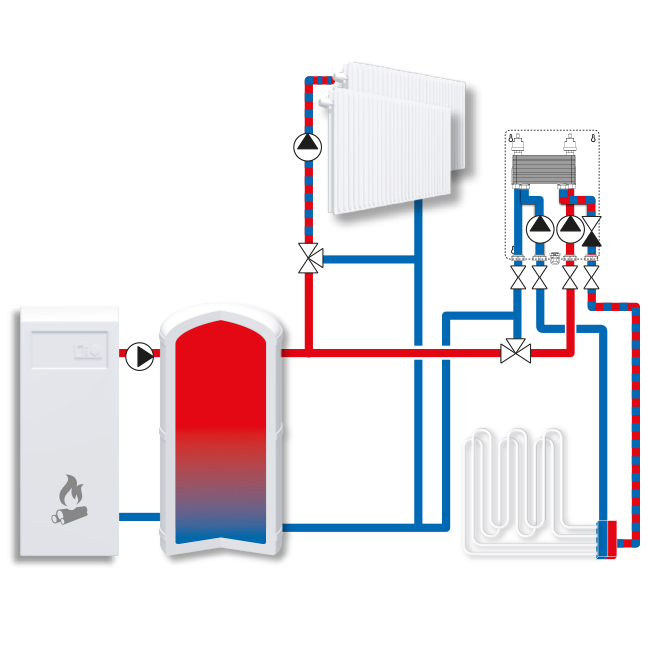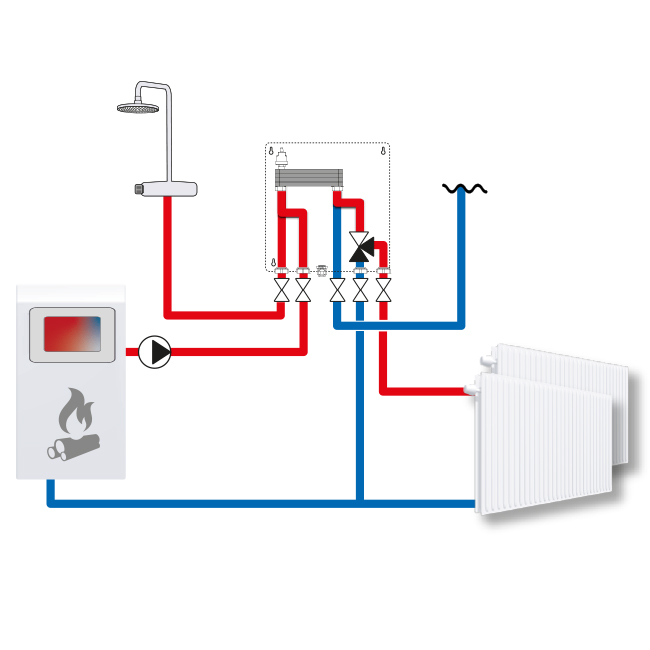WHY YOU NEED HYDRAULIC SEPARATION UNITS
2024-06-20
ESBE offers a well-sorted and market-leading range of products for liquid-based systems that include heating, cooling, and tap water systems. In 2024, the range was expanded with three hydraulic separation units: ESBE series SKP100 , ESBE series SKS100 , and ESBE series SKC100 .
Here we briefly explain what differentiates the various separation units.

ESBE series SKP100
ESBE’s separation unit series SKP100 is designed to separate two heating circuits in a heating system. This can include separating two heat sources in a hybrid system or separating the primary and secondary circuits to prevent oxygen from entering the primary circuit and damaging the boiler.
Facts about the SKP100 separation unit:
• Comes with a 30 kW plate heat exchanger
• Comes with a Wilo PARA 8 pump and check valve
• Prepared for installation of a secondary pump
• Prevents oxygen in the water from corroding and damaging the boiler
• Prevents lime and dirt from blocking the heat exchanger’s water pipes
• Protects against unexpected costly maintenance and downtime
• Pre-assembled and pressure tested
• Quick and easy installation
• Ensures the system meets INAIL requirements*
• Can be equipped with CSK211 control (accessory)

SKP100 with two heat sources (gas boiler and water fireplace). SKP100 provides hydraulic system separation. The fireplace has its own circulation pump.

SKP100 is used to separate underfloor heating systems and has been equipped with an extra pump (accessory) to receive water from the tank.
ESBEs series SKS100
ESBE’s separation unit series SKS100 is intended for tapwater where the heat sources are fueled by solid fuel, such as water-jacketed fireplace, wood stoves, and pellet boilers.
Facts about the SKS100 separation unit:
• Comes with a 20 kW plate heat exchanger
• Comes with a diverting valve
• Delivers 12 litres of tapwater per minute at 45 °C
• Pre-assembled and pressure tested
• Quick and easy installation
• Ensures the system meets INAIL requirements*
• Can be equipped with CSK211 control (accessory)

SKS100 provides hot water from the solid fuel boiler. The boiler has its own pump.
ESBEs series SKS100
ESBE’s separation unit series SKS100 is intended for tapwater where the heat sources are fueled by solid fuel, such as water-jacketed fireplace, wood stoves, and pellet boilers.
Facts about the SKS100 separation unit:
• Comes with a 20 kW plate heat exchanger
• Comes with a diverting valve
• Delivers 12 litres of tapwater per minute at 45 °C
• Pre-assembled and pressure tested
• Quick and easy installation
• Ensures the system meets INAIL requirements*
• Can be equipped with CSK211 control (accessory)

SKS100 provides hot water from the solid fuel boiler. The boiler has its own pump.
ESBE series SKC100
ESBE's separation unit series SKC100 is designed to separate two heating circuits in a heating system and provide tapwater.
Facts about the SKC100 separation unit:
• Comes with a 30 kW plate heat exchanger + 20 kW plate heat exchanger for tap water preparation
• Comes with a Wilo PARA 8 pump
• Comes with a check valve and diverting valve
• Delivers 12 litres of tapwater per minute at 45 °C
• Pre-assembled and pressure tested
• Quick and easy installation
• Flexible construction that can be upgraded
• Ensures the system meets INAIL requirements*
• Can be equipped with CSK211 control (accessory)

The connection example shows an extra pump, available as an accessory.
SKC100 provides heating and tapwater from two heat sources (gas boiler and water-jacketed fireplace) through hydraulic system separation. The unit has an extra circulation pump as the heating water from the water fireplace does not include one.
Benefits of heat exchangers
Heat exchangers can be used to enable the use of different liquids in two connected circuits. To avoid oxygen entering the primary circuit from the secondary side and damaging the boiler (a common problem in old systems), a heat exchanger can be installed to separate the circuits. The heat exchanger also allows for pressure differences between the primary and secondary circuits.
Another advantage of using a heat exchanger is that it enables the efficient operation of a heating system with both solid fuel boilers (such as a water-jacketed fireplace, wood-burning stove, or pellet burner) and gas or oil boilers. The heat exchanger ensures the system operates correctly by preventing issues that can arise when different heat sources work together, such as excessive equipment wear or inefficient heat production.
*INAIL regulation/ISPESL 2006-09-18 is a requirement in Italy that mandates hydraulic separation in heating systems when two different heat sources are used together, and the combined output exceeds 35 kW.
Related links
ESBE hydraulic separation units »




















